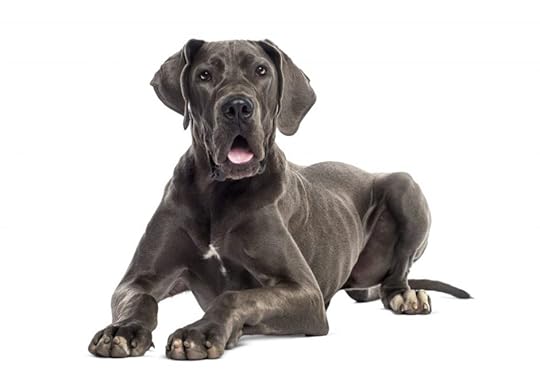Canine Bloat: Know the Signs, Save A Life
Canine Bloat: Know the Signs, Save A Life

Great Dane dogs are at highest risk for canine bloat.
Canine bloat affects up to 60,000 dogs each year, and goes beyond a tummy ache. I worry about this because German Shepherd Dogs are one of the high risk breeds. Bloat (more technically called gastric dilatation volvulus) can cause a painful death.
I’m sharing a partial excerpt of the CANINE BLOAT entry from Dog Facts, The Series #2 (Chapter B) covering Babesiosis, Bad Breath, Balanopothitis, Bitch, Bladder Stones, Bleeding, Blindness, Bloat (Gastric Dilatation-Volvulus), Blood, Botulism, Breed, Bronchitis, Brucellosis, and Burns. I’ve broken the massive book into discounted treat-size alpha-chapter sections. Folks can choose which ones they most need. Each chapter will release every other week. Of course, you can still get the entire book either in Kindle or 630+ pages of print.
WHAT IS CANINE BLOAT?
Gastric dilitation is the painful swelling of the stomach with gas and/or frothy material. Volvulus is the rotation, or twisting, of the stomach. Bloat refers to one or both scenarios, and either can result in death.
When bloat occurs, the stomach contents cannot be expelled either by vomiting, burping, or by passing into the intestines. The stomach distention causes pressure on other internal organs, which results in shock. If the stomach twists, circulation is cut off and the stomach and spleen can die. The rotation also compresses a vein that returns blood to the heart, resulting in severe depression of normal blood circulation.

Canine bloat can affect any dog but large dogs are at highest risk.
WHAT DOGS ARE AT RISK FOR CANINE BLOAT?
All dogs can be affected, but purebred dogs are three times more likely to suffer bloat compared to mixed breed dogs. Breeds that have a narrow but deep chest have the greatest incidence of the condition.
Great Danes have the highest incidence. They have a 40 percent chance they’ll have an episode before they reach age seven. A recent survey estimated the lifetime risk of bloat at 24 percent for large breed (50 to 99 pounds) and 22 percent for giant breed dogs (over 99 pounds). Some research indicates nervous dogs have a twelve times higher risk than calm, happy dogs.
CANINE BLOAT SYMPTOMS
restlessness
unproductive attempts to vomit or defecate
swollen, painful stomach
pale gums
irregular breathing
collapse and death
EMERGENCY! Veterinary Diagnosis & Treatment
When a high-risk dog suffers any of the above symptoms, don’t wait. Emergency treatment can save your dog’s life. The stomach contents must be removed to reduce the pressure, and passing a stomach tube manages the distension. When the stomach twists, though, the tube won’t pass and surgery is required to return the organs to normal position, and evaluate any damage to the spleen or other tissue.

Managing meals can reduce the risk of canine bloat in Great Danes and other dogs.
What Is Gastropexy for Canine Bloat?
In high risk dogs, and those that have survived a bloat episode, gastropexy surgery is recommended. That fixes the stomach to the body wall so it can’t twist. Gastropexy prevents a recurrence of the condition in more than 90 percent of cases. It can be done at the same time as spay or neuter surgery, and laparoscopic surgery techniques can make the procedure much less invasive and reduce recovery time. Dogs with gastric dilatation-volvulus that do not undergo a gastropexy have recurrence rates of more than 70 percent and mortality rates of 80 percent.
Can Canine Bloat Be Prevented?
Although bloat can’t be completely prevented, predisposing factors can be reduced. Limiting water and exercise before and after meals, commonly recommended in the past, in fact did not reduce the incidence of bloat in more recent studies. Another recommendation—raising the food bowl—actually increased the risk of bloat by about 200 percent.
Avoid sudden changes in food, which can prompt gorging behavior. When a diet change is necessary, introduce it gradually over a seven to ten day period. Meal-feed your dog small quantities of food several times a day, rather than feeding all at once. And if there’s food competition between your dogs, feed them in separate rooms to help slow gulpers and calm their anxiety over stolen food.
 Find out more details about canine bloat and other “B” topics in Dog Facts, The Series #2.
Find out more details about canine bloat and other “B” topics in Dog Facts, The Series #2.
Do you live with a high risk dog? Has your dog ever suffered from bloat? What steps do you take to reduce the risk? I hope you NEVER have to face this serious condition, and that learning more about the condition will help keep your beloved dog safe.
Subscribe to Amy’s YouTube Channel
I love hearing from you, so please share comments and questions. Do you have an ASK AMY question you’d like answered? Do you have a new kitten and need answers? Stay up to date on all the latest just subscribe the blog, “like” me on Facebook, and sign up for Pet Peeves newsletter. Stay up to date with the latest book give aways and appearances related to my September Day pet-centric THRILLERS WITH BITE!
AMY SHOJAI'S Bling, Bitches & Blood - Practical Solutions for Pets Problems & Publishing





